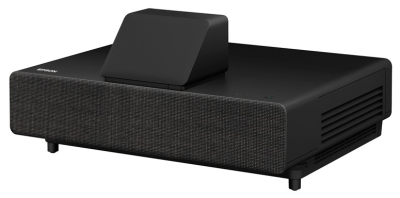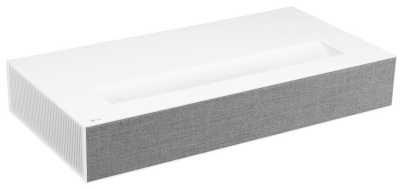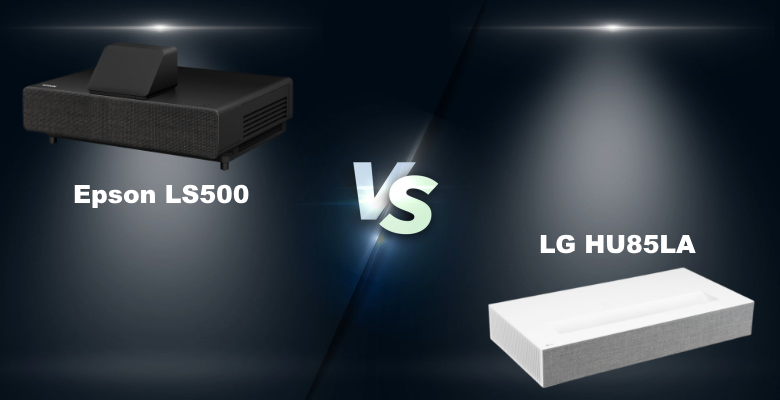Laser projectors are becoming the must-have in home entertainment systems. You get a brighter picture and there’s less maintenance since there aren’t any bulbs to replace. Laser projectors are also versatile thanks to their short-throw distance. You can set a laser projector up almost anywhere.
Two laser projectors that come with the features you expect are from Epson and LG. Both brands are well-known, but there are differences. When you compare the Epson LS500 vs the LG HU85LA, the LS500 does have better image and sound quality, but if you’re also interested in smart features the HU85LA comes with a few more. (>>> Find on Amazon).
Epson LS500 vs LG HU85LA Specifications:
| Epson LS500 | LG HU85LA | |
|---|---|---|
 |  |
|
| Resolution | 1920x1080 4K w/pixel shifting | 3840x2160 |
| Contrast Ratio | 2,500,000:1 | 2,000,000:1 |
| Brightness (Lumens) | 4,000 ANSI | 2,700 ANSI |
| Input Lag | 27ms | No data |
| Throw Distance | 0.7' - 1.9' | 1.3' - 1.7' |
| Screen size | 70" - 130" | 90" - 120" |
| Internal Speakers | 10.0 Watts × 2 | 5.0 Watts × 2 |
| Price | Find on Amazon ProjectorScreen.com Bhphotovideo.com | Find on Amazon ProjectorScreen.com Bhphotovideo.com |
Both laser projectors have a lot in common, including cinematic image quality. Some differences can make one a better option.
Image Quality
The LG HU85LA is a 4K laser projector. With 8 million pixels, images are sharp, clear, and detailed. The 2,700 lumens rating is low compared to similar projectors, but it’s still bright enough to counteract most external light. A 2,000.000:1 contrast ratio ensures deep blacks and brilliant whites.
Even though the Epson LS500 only has a 1920×1080 resolution, it makes up for it with advanced processing technology. The 4K Pro-UHD tech ensures a sharply detailed picture every time you use the projector, and a 4,000 lumens laser light source takes care of sunlight. You get a bright picture no matter if the lights in the room are on or off. The 2,500,000:1 contrast ratio is also higher than what you get with the HU85LA.
Better Image Quality: Epson LS500
Gaming Quality
Avid gamers won’t have any problems deciding which laser projector is best. The input lag on the LG HU85LA can drop to 16.7ms, but you also lose some image clarity. Without adjusting the settings, input lag is around 57ms. You’ll notice some blurring, and the frame-by-frame action isn’t as smooth on faster-paced games.
The LS500 doesn’t disappoint gamers. With a latency rate of 16.7ms, you won’t have any problems with graphics-rich games like GTA and Halo. Even multi-player games run smoothly.
Better Gaming Quality: Epson LS500
Smart Features
A quick comparison between the two laser projectors shows you the HU85LA is the winner. You do have the advantage of an Android operating system with the LS500. You can download your streaming apps like Netflix, Hulu, and Prime. Google Assistant is also supported.
The HU85LA comes with this and more. Along with Google Assist, you also have Alexa voice control. Miracast is supported for streaming directly to the projector from your mobile device. You’ll also notice that you get more wireless connectivity options with the LG laser projector.
Better Smart Features: LG HU85LA
Audio Quality
You don’t want to give up your sound system with either projector. The onboard speakers are better than what’s on your TV, but only by a little. The LS500 does have better audio quality over the HU85LA’s dual 5W speakers. The two 10W speakers produce a more powerful sound that matches the on-screen action.
Better Audio Quality: Epson LS500
Epson LS500

You may need less than a foot of space for 100” images but get ready for the projector’s weight. At 44.80lbs, it’s not something you want to carry around. It’s not designed for portability. What it is designed for, is to produce bright images. You get accurate, dynamic colors, and bright images in any lighting. 4K Pro-UHD projection and 10-bit HDR processing give you an incredible viewing experience.
Even though it’s lacking some smart features, the LS500 does come with an Android operating system and Google Assist. Voice control will search for content but can’t playback or adjust the volume.
The Epson LS500 also comes with everything you need. It’s one of the best laser projectors for first-time owners. Along with the projector, you get a compatible screen. Depending on how far the projector is from the screen, you can throw 100” images.
Pros
- 10-bit color processing for 4K resolution
- Bright colors
- Dynamic contrast
- Screen is included
- 10W speakers
Cons
- Miracast is not supported.
- Google Assist commands are limited
LG HU85LA

Not only does the LG HU85LA boast a sleek, minimalist design, but it’s also easier to move around. At 26.9lbs, you won’t struggle to carry outside for a fun movie night under the stars. With a throw distance of 7.1 inches, you can watch 100” images on the screen or a blank wall.
Even though the lumens rating is low, you still get a bright, dynamic picture. 4K resolution, combined with HDR10 technology support give you accurate colors and rich detail. Dynamic tone mapping and TruMotion technology prevent motion blur on action scenes and games.
With the HU85LA, you also get plenty of smart features. Voice control through Alexa and Google Assist are supported, along with their functions. You can stream content from apps or use Miracast with any compatible device.
Pros
- 4K resolution
- Low latency speed
- Voice control
- Screen included
- Android OS
Cons
- Low lumens rating
- Hard to align onscreen images
Conclusion
If you know what you want, comparing the Epson LS500 vs the LG HU85LA is easy. Gamers and anyone that wants lots of smart features will pick the LG HU85LA. The Epson LS500 does produce brighter, more detailed images in almost any lighting. Anyone that wants a laser projector they can use anytime will want the Epson LS500 (>>> Check the current price on ProjectorScreen).
Even though the Epson LS500 is the better pick for audio and image quality, the HU85LA still has plenty to offer consumers.
